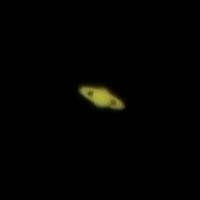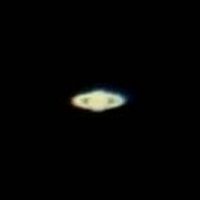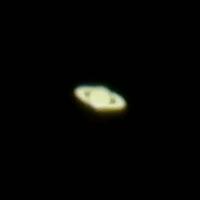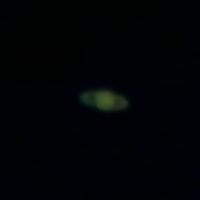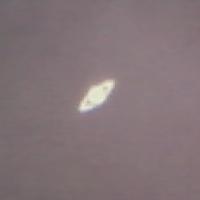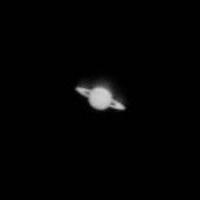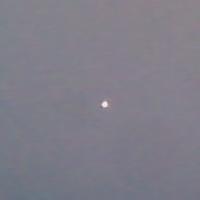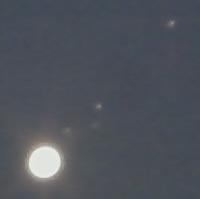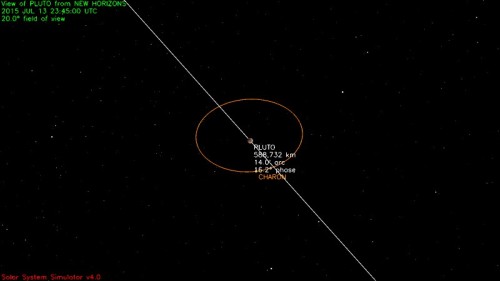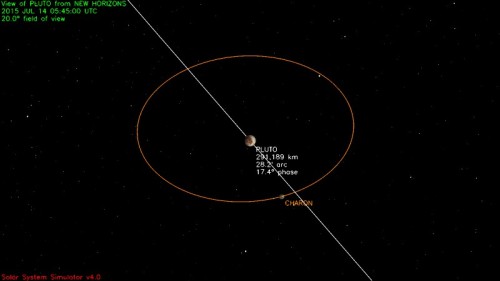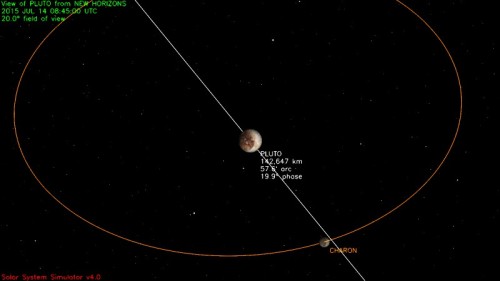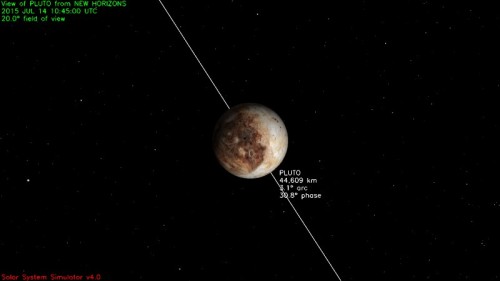Posted in 9-11 | Tagged 9-11 | Leave a Comment »
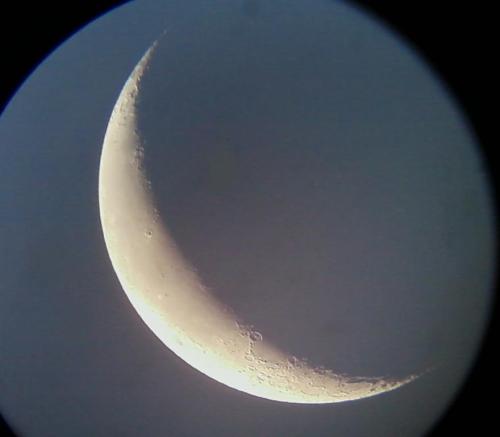
Above: Waning Crescent Moon at 5:53 AM CDT August 2, 2013 (10:53 UT), 8″ reflector telescope with 25mm eyepiece.
Below: Jupiter and its four largest Moons offer an ever-changing space-scape, though in the photo below you can’t see Io, which was transiting Jupiter’s face at the time.
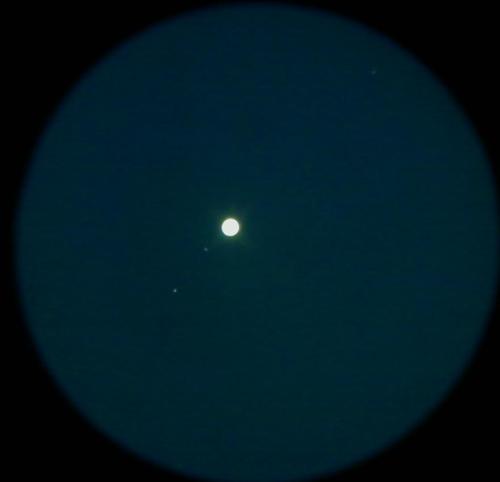
From left to right: Ganymede, Europa, Jupiter, Callisto, 5:29 AM CDT (10:29 UT).
Below: 29 minutes later, the lightening sky helps me photograph Jupiter’s atmospheric cloud belts. 5:58 AM (10:59 UT):
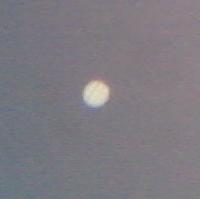
When the sky is darker, the photometer on my cell phone camera tries to take in as much light as possible, resulting in loss of planetary detail due to overexposure. But the lightening sky floods the camera with light, causing the photometer to kick down the light level, revealing more detail. Just something I’ve learned as a low-budget astrophotographer. :O)
Jupiter photos with 8″ reflector telescope, 25mm eyepiece and 2x Barlow. All with LG VX8360 cell phone camera.
Posted in Astronomy, Astrophotography, Jupiter photos, Moon photos | Tagged Astronomy, Cell phone astrophotography, crescent Moon, Jupiter & Galilean Moons, Moon photos, waning crescent Moon | Leave a Comment »
Saturn is very nicely placed for evening viewing after sunset during mid to late summer this year. Also, since it is currently at eastern quadrature (a fancy way of saying that the Earth and Saturn are at an especially wide angle from each other with respect to the Sun), it’s currently possible to observe Saturn’s shadow on the rings behind it, and I think I managed to capture a hint of it in the first photo below, even with my supremely modest equipment. It would be on the lower right portion of the rings adjacent to the planet in the photo.
All with 8″ reflector telescope and LG VX8360 cell phone camera. Unless otherwise noted, 17mm eyepiece with 2x Barlow.
Posted in Astronomy, Saturn photos | Tagged Astronomy, Cell phone astrophotography, Saturn, Saturn photos | 2 Comments »
Venus and Jupiter are the two brightest planets, and these days Jupiter is appearing as a brilliant “morning star” in the east before dawn, whereas Venus is appearing as a bright “evening star” in the west after sunset.
Below: Jupiter and dimmer Mars close together in the predawn sky.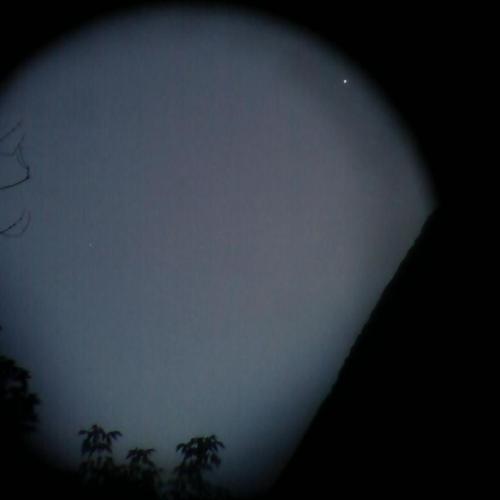
Mars is left center, brighter Jupiter is upper right. 5:23 AM CDT July 29, 2013, 7×35 binoculars.
Beautiful skies like this one keep me getting up before dawn:

Below are photos of Mars (currently quite far away), Jupiter, and Venus shown at the same magnification:
The following photos are all of Venus. Venus passed around the far side of the Sun (superior conjunction) on March 28, and is now gradually approaching the Earth once again:
 |
7:15 PM CDT July 28, 2013 (00:15 UT July 29, 2013) Angular diameter 12.37 arc seconds 83.6% illumination Distance from Earth 125,386,985 miles (201,790,791 km) |

|
12:05 PM CST, November 19, 2012 (18:05 UT) Angular diameter 12.25 arc seconds 85.6% illumination Distance from Earth 126,593,857 miles (203,733,064 km) |

|
1:12 PM CDT, October 12, 2012 (18:12 UT) Angular diameter 14.69 arc seconds 74.6% illumination Distance from Earth 105,565,517 miles (169,891,262 km) |
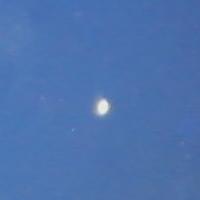
|
2:00 PM CDT, September 21, 2012 (19:00 UT) Angular diameter 16.83 arc seconds 67.3% illumination Distance from Earth 92,101,088 miles (148,222,333 km) |

|
8:26 AM CDT, September 10, 2012 (13:26 UT) Angular diameter 18.36 arc seconds 62.7% illumination Distance from Earth 84,452,528 miles (135,913,169 km) |

|
10:17 AM CDT, September 4, 2012 (15:17 UT) Angular diameter 19.31 arc seconds 60.1% illumination Distance from Earth 80,311,754 miles (129,249,240 km) |
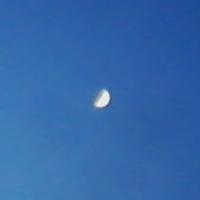
|
1:15 PM CDT, August 21, 2012 (18:15 UT) Angular diameter 22.02 arc seconds 53.5% illumination Distance from Earth 70,401,199 miles (113,299,747 km) |

|
7:36 AM CDT, August 13 2012 (12:36 UT) Angular diameter 24.07 arc seconds 49.1% illumination Distance from Earth 64,429,600 miles (103,689,390 km) |

|
1:39 PM CDT, August 6, 2012 (18:39 UT) Angular diameter 26.05 arc seconds 45.2% illumination Distance from Earth 59,516,628 miles (95,782,727 km) |

|
8:52 AM CDT July 30, 2012 (13:52 UT) Angular diameter 28.56 arc seconds 40.6% illumination Distance from Earth 54,298,771 miles (87,385,401 km) |
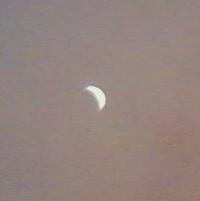
|
5:49 AM CDT July 22, 2012 (10:49 UT) Angular diameter 31.96 arc seconds 34.9% illumination Distance from Earth 48,512,519 miles (78,073,332 km) |

|
9:18 AM CDT July 13, 2012 (14:18 UT) Angular diameter 36.52 arc seconds 27.9% illumination Distance from Earth 42,450,876 miles (68,318,063 km) |

|
11:56 AM CDT July 3, 2012 (16:56 UT) Angular diameter 42.79 arc seconds 19.0% illumination Distance from Earth 36,238,688 miles (58,320,514 km) |

|
11:21 AM CDT June 27, 2012 (16:21 UT) Angular diameter 47.07 arc seconds 13.4% illumination Distance from Earth 32,940,927 miles (53,013,283 km) |

|
8:38 AM CDT June 21, 2012 (13:38 UT) Angular diameter 51.42 arc seconds 7.8% illumination Distance from Earth 30,154,150 miles (48,528,401 km) |

|
8:57 AM CDT June 12, 2012 (13:57 UT) Angular diameter 56.46 arc seconds 1.6% illumination Distance from Earth 27,463,558 miles (44,198,313 km) |

|
7:33 PM CDT June 5, 2012 (00:33 UT June 6, 2012) Angular diameter 57.78 arc seconds 0.0% illumination, transiting the Sun Distance from Earth 26,836,379 miles (43,188,966 km) Projection method with 60mm refractor telescope and 17mm eyepiece |
Posted in Astronomy, Astrophotography, Jupiter photos, Mars photos, Venus photos | Tagged Astronomy, Cell phone astrophotography, Jupiter & Galilean Moons, Mars photos, Mars-Jupiter conjunction, Venus phases, Venus Photos | Leave a Comment »
Today marks one year since the passing of our Pluto:

Above: Pluto with Mom and my great nieces and nephews, in a moment of perfect sweetness, just one hour before he died.
I find it appropriate and touching that the third anniversary of Pluto’s passing will be marked by a different kind of passing of a different kind of Pluto. Two years from now, barring some space disaster, the New Horizons spacecraft will be entering the vicinity of the (currently classified as) dwarf planet Pluto after 7 1/2 years of swift travel. The spacecraft will make its closest approach to Pluto on July 14, 2015. As a way of dramatizing and building anticipation for this momentous event, here’s a series of simulated images generated via one of my favorite online utilities, the NASA-JPL Solar System Simulator:

Above: Today Pluto remains a tiny dot as viewed from the spacecraft.
Below: The next six images dramatize New Horizons’ final approach during July 12-14, 2015. The elliptical path represents the orbit of Charon, Pluto’s largest moon:
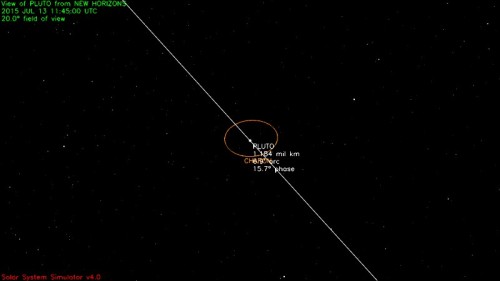
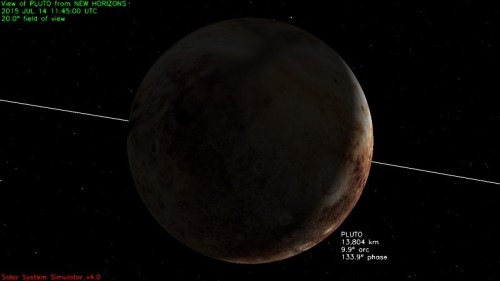
Seven images above Courtesy NASA/JPL-Caltech. Click to enlarge.
Posted in Astronomy, Life events, New Horizons Space Probe, Pets, Pluto | Tagged Astronomy, New Horizons, Pets, Pluto | Leave a Comment »
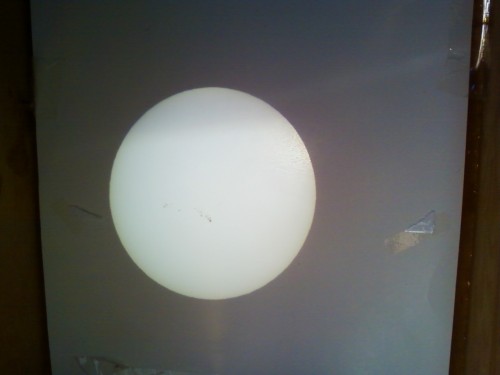
Above: My extremely humble, unedited photo of the Sun with a dramatically large sunspot group currently visible. I could even see the largest spot using the eclipse shades we used for observing the May 20, 2012 solar eclipse. Read all about it and see some very sharp photos at Spaceweather.com. Solar projection method with 60mm refractor telescope and 17mm eyepiece.
Below: Waning Crescent Moon at 5:37 AM CDT July 3, 2013 (10:37 UT). 8″ reflector telescope, 25mm eyepiece.
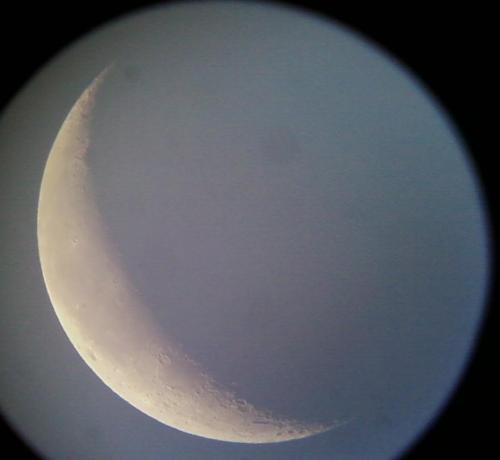
At the neighborhood park, at dawn on July 3:
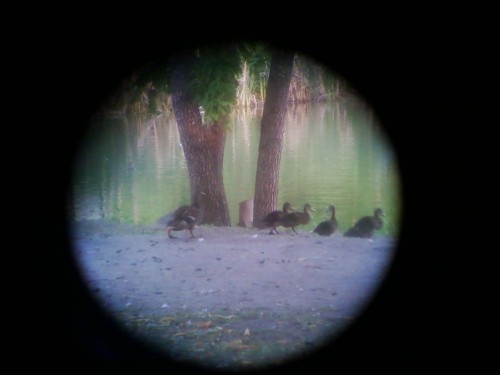
Above: A mother Mallard and half-grown ducklings heading towards the water.
Below: I was very pleased to see a mother Wood Duck with eight ducklings!
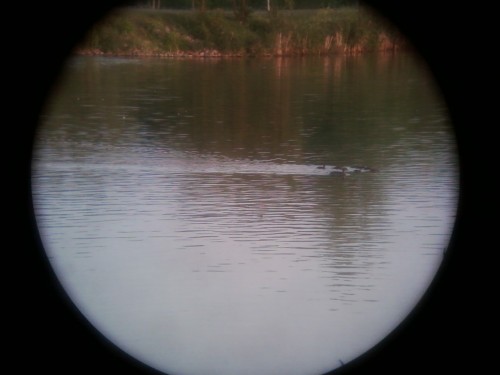
Photos above with 7×35 Bushnell binoculars.

Above: It’s amazing how much wildlife one can see so close to the city, and you see more by coming out at a quiet time such as the early morning.
Below: A very calm dragonfly, no doubt looking forward to a fine day of mosquito hunting.

It’s good to get down to the neighborhood park again. Once I was there once or twice a day, but not very often for almost a year. The park is full of memory for me, the memory of two thousand walks with Pluto during the last two and a half years of his long life. But life goes on, new ducklings and all!

All with LG VX8360 cell phone camera. Click to enlarge.
Posted in Astronomy, Astrophotography, Life events, Moon photos, Pets, Sun photos, Wildlife | Tagged Cell phone astrophotography, Dragonfly, Ducklings, ducks, Pets, Sunspots, waning crescent Moon | Leave a Comment »
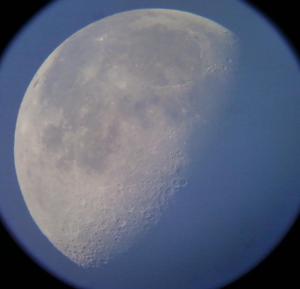
Above: 6:50 AM CDT 6-28-13 (11:50 UT)
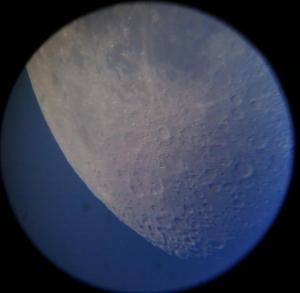
Above: The southern portion of the Moon, including Tycho and Clavius at 6:45 AM CDT.
Below: The northern portion of the Moon, including Plato and Mare Frigoris, 6:48 AM CDT.
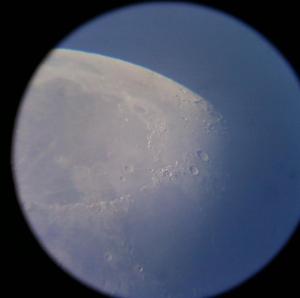
130x closeups with 2x Barlow, all (including 65x Moon photo) with 8″ homebuilt reflector telescope, 25mm eyepiece, LG VX8360 cell phone camera. Click to enlarge.
Posted in Astronomy, Astrophotography, Moon photos | Tagged Astronomy, Cell phone astrophotography, waning gibbous Moon | Leave a Comment »
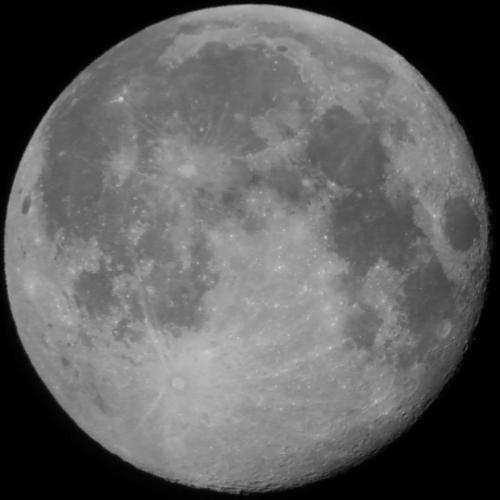
Lately the media have been heralding the occurrence of “Supermoons,” that is, times when the Full Moon coincides with perigee, the place in the Moon’s orbit when it’s closest to Earth. I’m happy to break over two months of non-blogging with the photo above, from this morning at 3:46 AM CDT (8:46 UT June 24, 2013). Compare with the earlier photos below, one taken at apogee (furthest from Earth) and the other at perigee, the especially “super” Supermoon of March 2011:
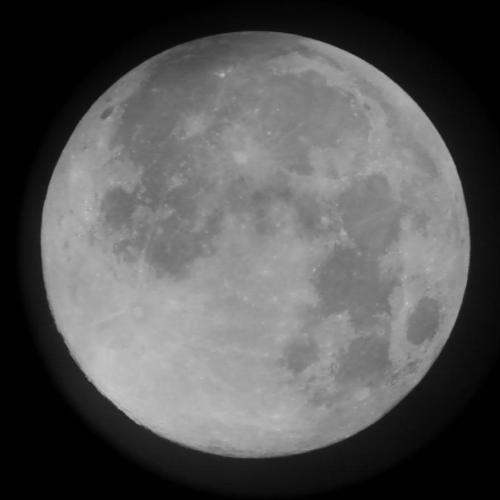
Above: 11:46 PM CDT October 11, 2011 (4:46 UTC), just 2 hours and 40 minutes after the time of greatest full phase. The Moon was 252,500 miles from Earth.
Below: March 2011’s “Supermoon,” 3:34 AM CDT March 19, 2011 (8:34 UTC). The Moon was 221,700 miles from Earth.
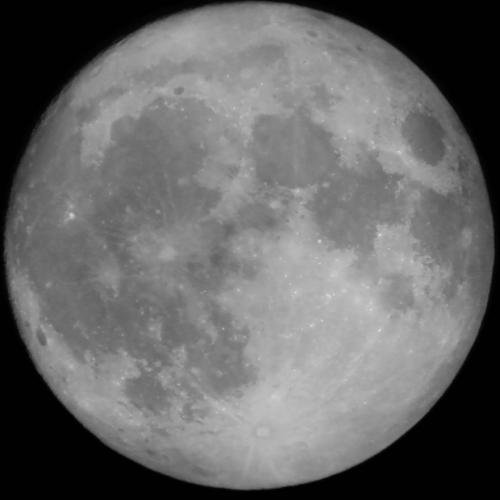
Both with LG VX8360 cell phone camera. Click to enlarge.
Posted in Astronomy, Astrophotography, Moon photos, Moon's orbit | Tagged Astronomy, Cell phone astrophotography, Moon photos, Supermoon | 2 Comments »
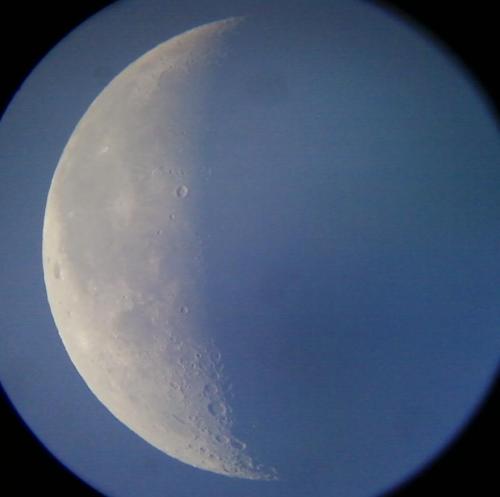
7:09 AM CDT April 3, 2013 (12:09 UT). 8″ reflector telescope, 25mm eyepiece, LG VX8360 cell phone camera. Click to enlarge.
Don’t forget to look for Comet Pan-STARRS while it’s close in our sky to the Andromeda Galaxy!
Comet Pan-STARRS Offers M31 Photo Op (Sky and Telescope)
Posted in Astronomy, Astrophotography, Moon photos | Tagged Astronomy, Cell phone astrophotography, Comet Pan-STARRS, comets, Moon photos, waning crescent Moon | Leave a Comment »
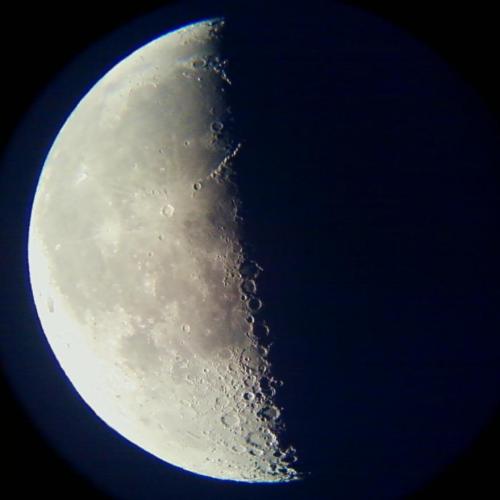
6:41 AM CDT April 3, 2013 (11:41 UT), 8″ reflector telescope with 25mm eyepiece.
The splendid crater Copernicus is Number 5 in Charles A. Woods’ Lunar 100 and can be easily seen in the photo above, and even more prominently in the upper center of this closeup from October 19, 2011, at 7:49 AM CDT (12:49 UT):
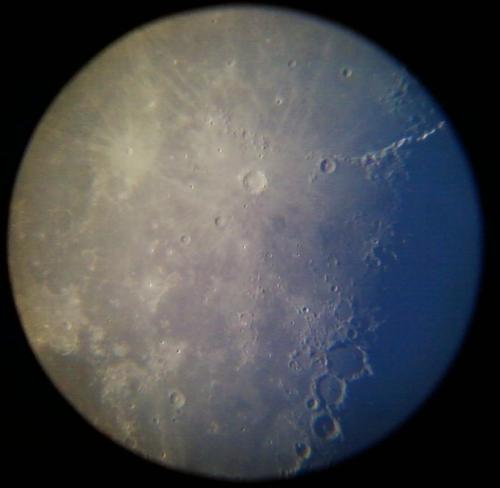
8″ reflector telescope, 25mm eyepiece, 2x Barlow.
It is a favorable time to view Saturn, as it is approaching opposition on April 28, at which time it will make its closest approach to Earth for this year. Here’s an update:
Last but not least, I’m happy to report that on Sunday evening I made a clear sighting of Comet Pan-STARRS, which this week is passing right by the Andromeda Galaxy, so don’t miss it, because it’s one of the best times available to use a major astronomical “landmark” to find the comet! I don’t expect to post any pictures, as the comet is too faint for my modest photo equipment. but Nathan P. Hoffman succeeded in capturing it here, and a great place to watch for the latest amateur photos is www.spaceweather.com/.
Almost forgot – my photos are taken with an LG VX8360 cell phone camera, as usual. Gotta love the internet … a guy with no money can aim his pocket camera into a weathered old telescope and turn it into an astronomy site …
Posted in Astronomy, Astrophotography, Lunar 100, Moon photos, Saturn photos | Tagged Astronomy, Cell phone astrophotography, Comet Pan-STARRS, comets, Lunar 100, Moon, Moon photos, Saturn photos, waning crescent Moon | Leave a Comment »

